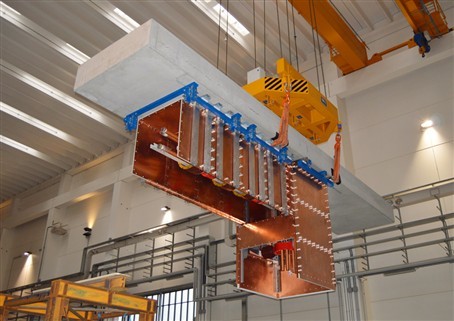Transmission line connection to SPIDER vessel completed


Under the stars and a bright shining moon, colleagues from F4E, COELME and Consorzio RFX celebrated: at eleven o’clock that night, the installation of the transmission line for SPIDER was completed at the Neutral Beam Testing Facility (NBTF) site in Padua, Italy. F4E have collaborated with the Italian company COELME in order to design, manufacture and install the 35 metre long transmission line which will connect the power supplies to the SPIDER beam source and transmit the energy required for its operation. The transmission line itself is not straight but deliberately built in a winding manner within a concrete labyrinth to ensure the containment of the particles generated in the SPIDER vessel. In addition, it is made up of double-layered panels of copper and calcium silicate in order to mitigate electromagnetic interferences coming from SPIDER’s ion source which could compromise the operation of the power supplies.
“Installation has involved a great deal of work on-site”, says Daniel Gutierrez, F4E Technical Officer responsible for the transmission line. “With such a long component, there are many things that could have gone wrong and installation is very much dependent on the layout, indeed very little pre-assembly can be done in the factory”, he explains.
Why was the installation completed only so late in the night? “In order to test that the transmission line is working properly, we need to ensure vacuum conditions in the SPIDER vessel”, explains Gutierrez “It took several days to achieve the right conditions, and by the time the conditions were right, it was already seven o’clock in the evening. If we would have stopped then, we would have had to start over, so we decided to continue – right up until eleven o’clock in the night”, he smiles.
The transmission line feeds power into the SPIDER (Source for Production of Ion of Deuterium Extracted from Radio frequency plasma) machine – a test bed where the first full-scale ITER ion source will be tested and developed. The ion source produces ions (particles with electric charges – either positive or negative), from which neutral particles originate. These neutral particles will be injected in the ITER plasma in order for the plasma to obtain the temperature and conditions necessary for the fusion reaction to occur. SPIDER is located in the Neutral Beam Test Facility – the facility which will test all main aspects of ITER’s neutral beam heating system.